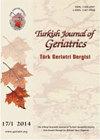假性剥脱综合征患者前庭系统及平衡功能的评估
IF 0.3
4区 医学
Q4 GERIATRICS & GERONTOLOGY
Turkish Journal of Geriatrics-Turk Geriatri Dergisi
Pub Date : 2023-03-01
DOI:10.29400/tjgeri.2023.335
引用次数: 0
摘要
引言:本研究旨在评估假性剥脱综合征患者的平衡和前庭系统。材料和方法:在一所大学医院进行前瞻性病例对照研究。研究人群包括37名患者(16名患者组,21名对照组)。感觉交互平衡的改良临床试验在四种条件下进行:1)睁开眼睛,表面坚硬;2) 闭上眼睛,表面坚硬;3) 闭眼,泡沫表面;和4)睁开眼睛,泡沫表面。在两组的所有条件下均采用平衡评分、前后位稳定性指数、中外侧稳定性指数。比较各组之间和组内的得分。此外,使用基于土耳其版本的改良瀑布疗效量表和老年人体力活动量表的问卷,对假剥脱综合征患者的体力活动进行了评估。结果:两组在睁眼或闭眼条件下的稳定性指数和平衡得分无显著差异;唯一的差异是睁开眼睛、坚硬表面条件下的平均中侧稳定性指数得分与假脱落组的低得分(p=0.01)。在组分析中,假脱落患者在坚硬和泡沫表面条件下闭眼时的平衡得分显著增加(p=0.001)。结论:假剥脱综合征患者在视力受损时,中枢神经系统会重新分配对感觉信息的依赖。他们的体感输入可能会以某种方式恶化,但前庭系统不会。关键词:眩晕;青光眼;…岁本文章由计算机程序翻译,如有差异,请以英文原文为准。
Assessment of Vestibular System and Balance Function in Patients with Pseudoexfoliation Syndrome
Introduction: This study aims to evaluate the balance and vestibular system of patients with pseudoexfoliation syndrome. Materials and Method: A prospective case–control study was performed in a university hospital. The study population consisted of 37 patients (16 patient group, 21 control group). The Modified Clinical Test of Sensory Interaction Balance was performed in four conditions: 1) eyes open, firm surface; 2) eyes closed, firm surface; 3) eyes closed, foam surface; and 4) eyes open, foam surface. The Equilibrium Score, Anteroposterior Stability Index, Mediolateral Stability Index were employed for all conditions in both groups. Scores were compared between and within groups. Additionally, the physical activity of the patients with pseudoexfoliation syndrome was assessed using questionnaires based on the Turkish versions of the Modified Falls Efficacy Scale and the Physical Activity Scale for the Elderly. Results: There were no significant differences in terms of stability index and equilibrium scores with eyes open or closed conditions between the two groups; the only difference was in the mean mediolateral stability index score in the eyes open, firm surface condition with low scores in the pseudoexfoliation group (p=0.01). In the group analysis, patients with pseudoexfoliation had a significant increase in the equilibrium scores when their eyes were closed in the firm and foam surface conditions (p=0.001 for both). Conclusion: The central nervous system redistributes its dependence on sensory information when vision is compromised in patients with pseudoexfoliation syndrome. Their somatosensory input might deteriorate in some way but not the vestibular system. Keywords: Dizziness; Glaucoma; Aged.
求助全文
通过发布文献求助,成功后即可免费获取论文全文。
去求助
来源期刊

Turkish Journal of Geriatrics-Turk Geriatri Dergisi
GERIATRICS & GERONTOLOGY-
CiteScore
0.60
自引率
0.00%
发文量
46
审稿时长
6-12 weeks
期刊介绍:
Turkish Journal of Geriatrics is a peer-reviewed journal. Official language of the journal is English. Turkish Journal of Geriatrics invites submission of Original Articles based on clinical and laboratory studies. Review Articles are published only after the invitation from the Editorial Board.
 求助内容:
求助内容: 应助结果提醒方式:
应助结果提醒方式:


